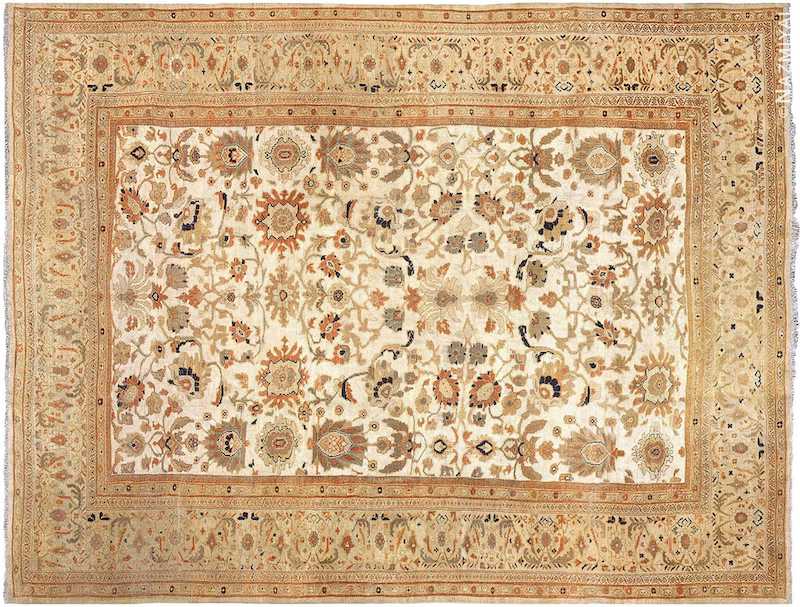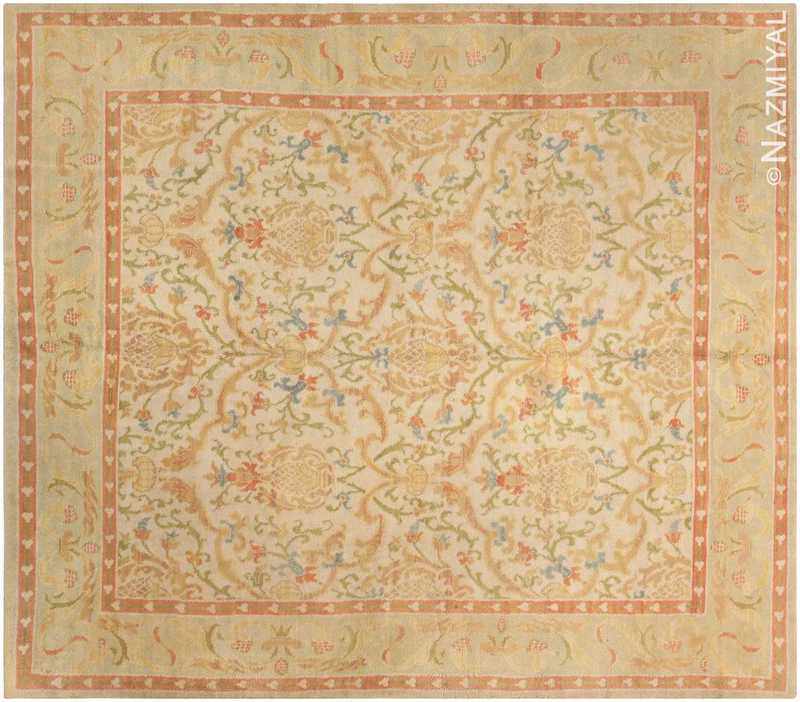Neoclassical Interior Design in Your Home
What Does Neoclassic Mean?
Neoclassic, also spelled as Neoclassical, refers to a revival or resurgence of classical forms, principles, and aesthetics in various artistic disciplines, particularly in the fields of architecture, visual arts, and literature. The term “neoclassic” is derived from the combination of “neo,” meaning “new” or “revived,” and “classical,” which refers to the artistic style of ancient Greece and Rome.
Neoclassicism emerged as a reaction against the extravagant and ornate styles of the Baroque and Rococo periods, which were prevalent in the 17th and 18th centuries. Neoclassical artists sought to revive the simplicity, order, and rationality of classical art and design, inspired by the ideals of ancient Greece and Rome. They emphasized clarity, symmetry, balance, and the use of classical motifs and architectural elements.
In neoclassical architecture, buildings often featured clean lines, simple geometric shapes, and classical orders such as Doric, Ionic, and Corinthian columns. Neoclassical painting and sculpture focused on portraying noble and heroic subjects, drawing inspiration from classical mythology and history.
In literature, neoclassicism emphasized reason, restraint, and intellectual rigor. Neoclassical writers often imitated the forms and themes of ancient Greek and Roman literature, favoring clear and precise language. They emphasized moral values, social order, and the power of reason over emotion.
Neoclassicism had a significant influence on the arts and culture of the 18th and 19th centuries, and its impact can still be seen in various architectural landmarks, artistic movements, and literary works.
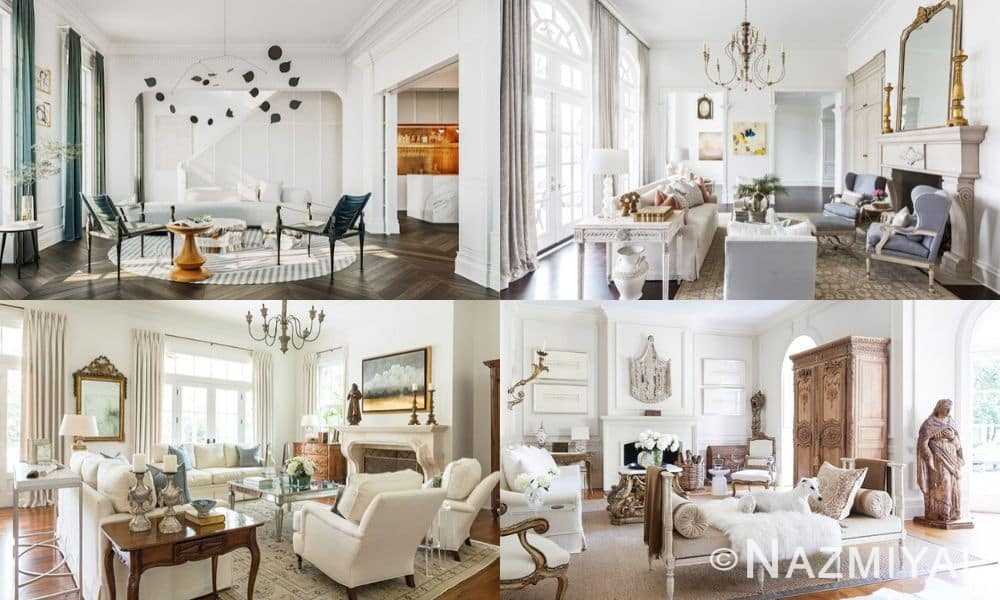
Neoclassical Interior Design
What Is Neoclassical Design?
Neoclassical design refers to the application of neoclassical principles and aesthetics in the realm of interior design and home decor. It draws inspiration from the neoclassical art and architecture of ancient Greece and Rome, particularly the revival that took place during the 18th and 19th centuries.
Neoclassical design embodies a sense of elegance, symmetry, and order. It embraces the classical elements of balance, proportion, and harmony while incorporating a restrained and refined aesthetic.
Some key characteristics of neoclassical design include:
- Architectural Elements: Neoclassical interiors often feature architectural details inspired by ancient Greek and Roman designs. These may include columns, pilasters, pediments, arches, and cornices, which are incorporated into doorways, mantels, and built-in furniture.
- Symmetry and Balance: Neoclassical design emphasizes a sense of balance and symmetry. Furniture arrangements, decorative elements, and artwork are typically organized in a symmetrical manner to create a visually pleasing and harmonious space.
- Classical Motifs: Neoclassical interiors often incorporate classical motifs and ornamentation. This may include Greek key patterns, laurel wreaths, acanthus leaves, rosettes, and other decorative elements derived from classical architecture and mythology.
- Colors and Materials: Neoclassical design tends to favor a restrained color palette with soft, muted tones. Shades of white, cream, beige, and pastels are commonly used, creating a sense of lightness and serenity. As for materials, neoclassical design employs natural materials such as marble, stone, wood, and silk to add a touch of luxury.
- Fine Furnishings: Neoclassical interiors often feature furniture with clean lines, symmetrical forms, and elegant details. Pieces are typically crafted from quality materials and showcase refined craftsmanship. Classical elements, such as fluted legs, carved details, and geometric shapes, are commonly incorporated into furniture designs.
- Accessorizing: Neoclassical spaces are adorned with tasteful accessories. Mirrors with ornate frames, classical sculptures, urns, vases, and busts of ancient figures are popular decorative items. Artwork often depicts classical themes, historical scenes, or portraits.
Neoclassical design offers a timeless and sophisticated aesthetic that blends historical references with a contemporary sensibility. It creates an atmosphere of refinement, order, and grace, evoking a sense of grandeur and elegance.
What is Neoclassical Interior Design?
Neoclassical interior design is a style of interior design that draws inspiration from classical Greek and Roman architecture, art, and design. This style emerged in the mid-18th century as a response to the overly ornate and decorative style of the Baroque design period. Neoclassical interiors are characterized by their simplicity, symmetry, and elegance, and are often associated with a sense of grandeur and formality.
In Neoclassical interior design, one can see the use of classical motifs, such as columns, arches, and pediments, as well as decorative elements like urns, busts, and classical friezes. Furniture in this style is often made from natural materials such as wood, marble, and stone and features clean lines and simple shapes. Colors are usually muted, with a focus on neutral hues like beige, ivory, and gray, and metallic accents such as gold, bronze, or silver may be used to add a touch of luxury.
Overall, Neoclassical interior design is all about creating a sense of balance, harmony, and order. It’s a style that has endured for centuries, thanks to its timeless elegance and classical beauty.
During the 18th and 19th centuries in Europe, and, to a lesser extent, America, neoclassical interior design emerged as one of the prevailing design trends, competing with Romanticism. Today, the style continues to be popular as a timeless aesthetic. Of course, most modern designers put unique contemporary touches on it. Nonetheless, much of the design language from the 1700’s is still noticeable.
What Are The Characteristics of Neoclassical Design?
Neoclassical interior design is based on the homes of wealthy Europeans and Americans in the 1700’s and early 1800’s. In turn, they based their style on (their conception of) the classical period, particularly ancient Greece and Rome.
This is seen in features such as paneling and molding, particularly imitating classical columns. Additionally, the style utilizes a lot of wood elements in furniture.
The style is marked by its elegance and timelessness. It is more modest compared to some of the more opulent aesthetics of the time. Nonetheless, there is an era-transcending luxury built into neoclassical.

Neoclassical interior design involves elegant molding, carved wood, antiques, and statues.
History of Neoclassical Interior Design
During the mid-18th century in Europe, the wealthiest members of society turned to the architecture of antiquity, the Vitruvian principles of design and the work of Renaissance architect Andrea Palladio for inspiration. This style influenced both the interior and exterior of buildings.
The rediscovery of Pompei and Herculaneum in the 1700’s helped spur an interest in classical home decor, especially in France and Italy. Many of the early efforts used the famous architectural motifs indoors rather than borrowing from the interiors of antiquity. However, as the style evolved, the interiors started to be based more closely on the furnishings and decor of the classical period.
Today, the style is still popular, although somewhat updated. Since it is more modest than the opulent Rococo and Baroque design styles that preceded it, neoclassical has managed to achieve a more timeless charm. There are many examples of neoclassical architecture and design in public buildings throughout the world.

Neoclassical design shows up in modern architectural elements, as well.
Using Neoclassical Interior Design in Your Home
As a popular design style today, neoclassical has an established charm that can feel elegant and appropriate in almost any space. Many people apply it when they want something cozier and classier than the spartan modernist styles.
Key Elements of Neoclassical Interior Design
As with all design styles, the key elements are colors, furniture and decorative motifs. Bringing these together with the right rug can help you transform a space:
Colors: Neoclassical colors tend to be very mild. They include white, cream, gray, yellow, blue, green and other muted hues. Black, red, silver and gold may be used as accent colors. Most patterns feature low-contrast palettes.
Furniture: This style is characterized by simple and symmetrical furniture. Furniture typically has exposed wood or metal structure providing an outline of the shape. Many pieces are embellished with ornamental ends. Upholstery is typically high-quality and luxurious without being ostentatious. A classical-style chaise lounge is a common feature of sitting areas.
Decorative Motifs: Floral motifs are common, especially in pillows, rugs and wall designs. Urns, jugs and statues are common decorations.
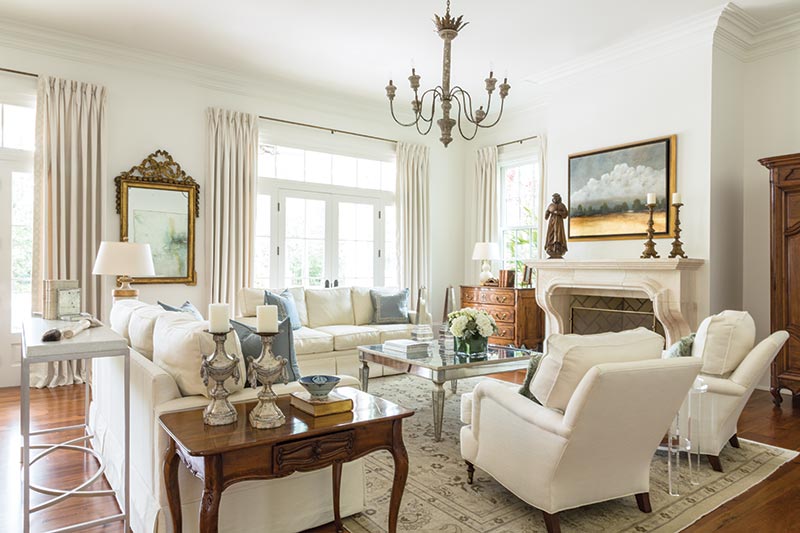
Neoclassical interior design makes a perfect cozy living room.
Although there is an elegant and luxurious nature to neoclassical, it is also a relaxed style. Finding this balance is the key to applying the style.
Applying These Elements
As you plan a space, start with a vision for the colors. The more muted palette is one of the most defining features of neoclassical. Define an area with a rug, ideally something with a gentle, floral or oriental pattern. Add to this some furniture. The antiquity-inspired furniture can really bring out the best features of this aesthetic. Although neoclassical is not a minimalist style, it shouldn’t be overly visually busy like some of its more opulent predecessors.
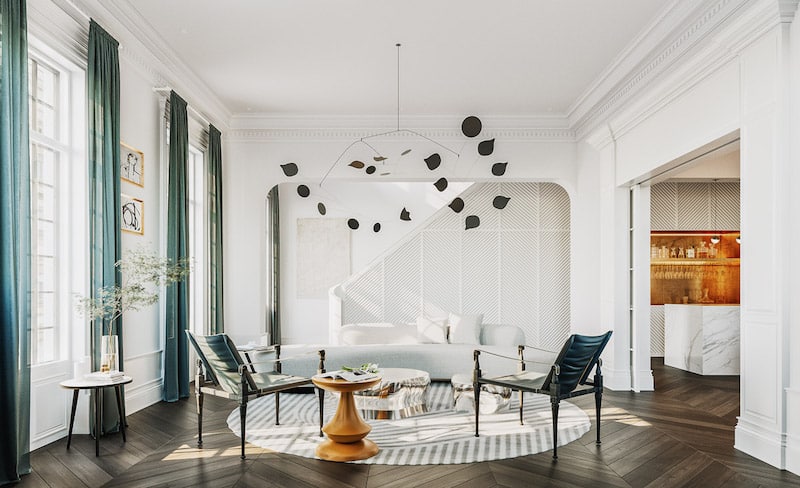
A modernized version of Neoclassical interior design.
Matching Rugs With Neoclassical Design
The right rug can bring together any style. Naturally, neoclassical should leverage antique or vintage rugs. The patterns are often nature-inspired. For example, floral patterns are a major motif in the style. Alternatively, use a geometric pattern to add a more modern touch to the aesthetic. This wasn’t typical in the 18th century but can look stunning today.
Typically, the best rugs for this style are relatively low contrast. However, sometimes a black and white rug can help to create a focal point in the room when needed. This can help to offset the blending of colors that happens naturally in neoclassical interiors.
Area rugs are very common in these designs. They are typically used on hardwood floors and not layered. Rugs with defined borders work well with this style because they add an extra sense of order.
Find the Perfect Rug for Your Décor
Rugs are among the most important elements of interior design. They help us to define spaces and set the tone for the rest of the décor. At Nazmiyal, we have pieces to fit any taste and aesthetic.
Explore our collection of antique, vintage and modern rugs. Whether you are looking for a piece to match your neoclassical room or a completely different style, we have the perfect rugs for you.
Here are some perfect rugs for Neoclassical interior design:
This interior design blog about Neoclassical interior design was published by Nazmiyal Antique Rugs.

